Ferrofluid Fun
Have you ever seen a liquid magnet? If magnetic material is ground into an extremely fine powder, with a particle size of about 10 nanometers (see Nanoguitar for more information on length units), and suspended in a liquid, the resulting magnetic suspension is called a ferrofluid.
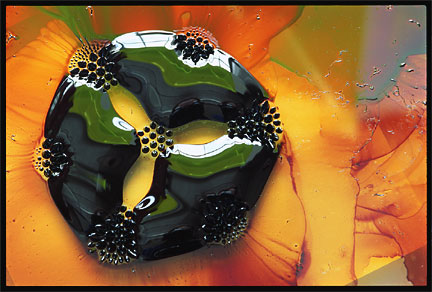
Ferrofluid, with permanent magnets underneath (photo courtesy of Felice Frankel, MIT)
![Magnetic particles, with surfactant molecules attached, suspended in a fluid to form a ferrofluid. The surfactant prevents clumping of the magnetic particles. (Drawing courtesy of Ferrotec Corporation [USA]). Magnetic particles, with surfactant molecules attached, suspended in a fluid to form a ferrofluid. The surfactant prevents clumping of the magnetic particles. (Drawing courtesy of Ferrotec Corporation [USA]).](/explore/action/images/ferrofluid-img2.jpg)
Magnetic particles, with surfactant molecules attached, suspended in a fluid to form a ferrofluid. The surfactant prevents clumping of the magnetic particles. (Drawing courtesy of Ferrotec Corporation [USA]).
A ferrofluid forms spikes along the magnetic field lines when the magnetic surface force exceeds the stabilizing effects of fluid weight and surface tension (see photo). The photo shows a ferrofluid on a flat surface, with permanent magnets underneath. Since the magnetic particles in the ferrofluid attract each other, they must be kept apart, so they are coated with a soap-like material called a surfactant (see drawing).
The ferrofluid has low resistance to flow, so it can function as a liquid O-ring seal, kept in place with permanent magnets. Ferrofluid seals prevent dust particles from working into disk drive mechanisms and crashing the drive head into the disk. Also, ferrofluids cool the coils of high-power, hi-fi speakers.
A possible future medical application might be an injectable ferrofluid that could be concentrated at a point in the body with an external magnetic field. The ferrofluid could deliver medication or act as a contrast agent for magnetic resonance imaging.
Research
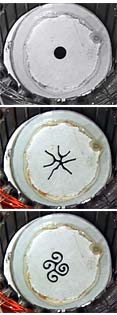
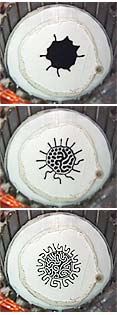
Sequences of ferrofluid patterns formed by a series of applied magnetic fields (top to bottom on left) and with the same fields applied in reverse order (top to bottom on right) (photos courtesy of Cory Lorenz)
Sometimes physics imitates art. An engineering undergraduate at MIT, Cory Lorenz, placed a drop of a ferrofluid between two closely-spaced glass plates, applied a constant vertical magnetic field, and then added a horizontal rotating magnetic field producing the interesting spiral design shown in the first group of photos (top to bottom on left).
But then Lorenz reversed the order of the applied fields, and saw a pattern (top to bottom on right), that looked something like Native American art, a completely unexpected result. A video of this transformation won a place in the annual APS Division of Fluid Dynamics Gallery of Fluid Motion, and can be seen with Windows Media Player or Quicktime (click on video in item 1 under V. Ferrohydrodynamics).
Out of this work could emerge possible applications of ferrofluids to tiny machines, on the scale of micrometers or nanometers. Unlike electric fields, magnetic fields cannot produce sparks, so they might provide a good way to produce more reliable micro and nano-machines.
Links
Minako Takeno
- Appearance of Magnetism 3
"The Ferrofluid"
University of Glasgow
MIT
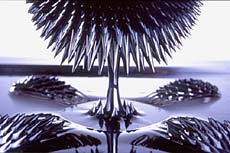
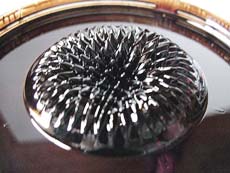
Left: "Protrude, Flow," showing ferrofluid with poles above and below (© Sachiko Kodama & Minako Takeno; Photo by Yozo Takada)
Right: Ferrofluid spikes above pole of ring ceramic magnet (photo courtesy of ForceField)














